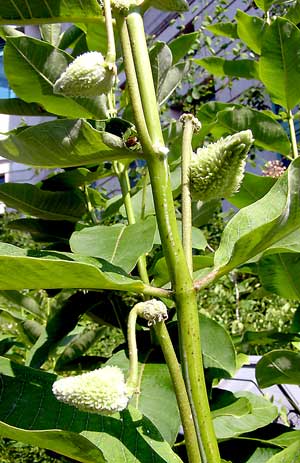Pollination on Jones Street

Baby seed pods of common milkweed are the result of successful pollination of the earlier flower clusters. Photo by Ken Moore.
By Ken Moore
Flora Columnist
It’s National Pollinator Week and we pause to honor pollinators. We should do it every week; that’s how important they are.
In addition to this Saturday’s Pollinator Celebration from 10 a.m. to 2 p.m. on the grounds of Chatham Marketplace in Pittsboro, plan a visit to the Museum of Natural Sciences in Raleigh, anytime, to learn more about the importance of insects as pollinators.
Your museum visit begins on the outside. The half-block-long north side of the museum along Jones Street is a wild garden, a dramatic contrast to the lawn and shrub monoculture of the North Carolina legislature across the street.
The museum’s wild garden is, by design, an assemblage of native plants representative of the state’s botanical diversity from seacoast to mountains. Though many of the plants from far reaches of the state will not survive on the museum’s harsh north bank, some, surprisingly, do, like the native mountain bush honeysuckle, Diervilla sessilifolia, which occurs naturally only at very high elevations. I wonder that there may be some similarities between the harshness of the museum’s urban site and the extremes of high-mountain conditions.
That wild garden attracts a great diversity of wild critters. Several species of birds nest there and feast on the variety of seeds, fruits and insects associated with the native plants. Praying mantises hunt atop the flower heads of Joe-Pye weed, Eupatorium fistulosum. Common buckeye butterflies linger on the flower heads of rattlesnake master, Eryngium yuccifolium. Leaves of common milkweed, Asclepias syriaca, provide sustenance for monarch butterfly larvae.
Museum curators frequently visit the wild garden to selectively harvest flowers, fruit and leaves to feed the living critters displayed inside. Most importantly, foliage, flowers and fruit and seed of the wildflowers, grasses and native trees and shrubs provide necessary food and cover for countless pollinating insects.
Folks walking by frequently pause to take closer looks at the color and movement in the wild garden. They express appreciation for such a different garden in the urban setting. But not all are so appreciative. On her way to work in the Legislative Building, a pleasant lady inquired, “Why does the museum have all those weeds?†I responded, “When those weeds are blooming, we call them wildflowers.â€
She lingered to explain to me how, growing up on a farm, her daddy always called those wild plants “weeds,†and the children had to help keep them away from the house to make room for the nicer cultivated plants.
When she noticed a butterfly weed, Asclepias tuberosa, she acknowledged that it made a pretty garden plant. Then she reflected on how her granddaddy took her walking in the woods and fields, talking about all sorts of wild plants. Some are good to eat, some make useful herbal medicines and some are just downright pretty. As she continued on her way, she acknowledged, “Well, all things considered, maybe we should all learn to appreciate those weeds.â€
After she left, I spied a mockingbird relishing the berries of pokeweed, Phytollaca americana, some unidentified warbler flitting about catching insects and butterfly larvae chewing milkweed leaves.
Then I appreciated that, largely unnoticed, the whole wild garden was alive with a host of insects visiting plants, unknowingly engaged in that vital function we call pollination. Thankfully, this action occurs every week.



Comments are closed.